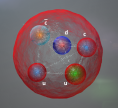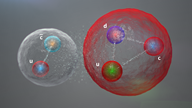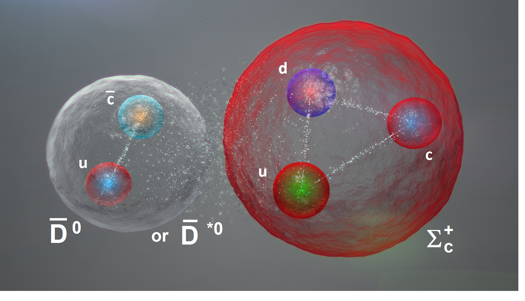m(Pc+(4312)) = 4311.9±0.7+6.8/-0.6 MeV, Γ = 9.8±2.7+3.7/-4.5 MeV
m(Pc+(4440)) = 4440.3±1.3+4.1/-4.7 MeV, Γ = 20.6±4.9+8.7/-10.1 MeV
m(Pc+(4457)) = 4457.3±0.6+4.1/-1.7 MeV, Γ = 6.4±2.0+5.7/-1.9 MeV
Today at the Rencontres de Moriond QCD conference, the LHCb collaboration announced the discovery of a new narrow pentaquark particle, Pc(4312)+, decaying to a J//ψ and a proton, with a statistical significance of 7.3 standard deviations. In addition, the Pc(4450)+ pentaquark structure previously reported by LHCb is also confirmed, but a more complex structure consisting of two narrow overlapping peaks, Pc(4440)+ and Pc(4457)+, is now emerging, with the two-peak structure having a statistical significance of 5.4 standard deviations compared to a single-peak hypothesis.
In the conventional quark model, strongly interacting particles known as the hadrons are formed either from quark-antiquark pairs (mesons) or three quarks (baryons). Particles which cannot be classified within this scheme are referred to as exotic hadrons. In their fundamental 1964 papers [1] and [2], in which they proposed the quark model, Murray Gell-Mann and George Zweig mentioned the possibility of adding a quark-antiquark pair to a minimal meson or baryon quark configuration. It took 50 years, however, for physicists to obtain unambiguous experimental evidence of the existence of these exotic hadrons. In April 2014 the LHCb collaboration published measurements that demonstrated that the Z(4430)+ particle, first observed by the Belle collaboration, is composed of four quarks (ccdu). Then, a major turning point in exotic baryon spectroscopy was achieved at the Large Hadron Collider in July 2015 when, from an analysis of Run 1 data, the LHCb collaboration reported significant pentaquark structures in the J/ψp mass distribution in Λb0→ J/ψpK– decays.
Various interpretations of these structures have been proposed, including tightly bound pentaquark states and loosely bound molecular baryon-meson state. These two possibilities are illustrated in the figure to the left. The color of the central part of each quark is related to the strong interaction color charge, while the external part shows its electric charge. The leftmost image illustrates how the quarks could be tightly bound; the image to the right shows a loosely bound meson-baryon molecule, in which a meson and a baryon are connected by a residual strong force similar to the one that binds protons and neutrons together within nuclei.
The analysis presented today used the combined data set collected by the LHCb collaboration in Run 1 (with pp collision energies of 7 and 8TeV, and corresponding to a total integrated luminosity of 3 fb-1) plus Run 2 (6 fb-1 at 13TeV). From this sample, 2.5×105 Λb0→ J/ψpK– decays were selected, nine times more than in the previous Run 1 analysis. The combined data set was analysed in the same way as in the earlier 2015 paper and the parameters of the previously reported Pc(4450)+ and Pc(4380)+ structures were found to be consistent with the original results. However, analysis of the much larger data sample reveals additional peaking structures in the J/ψp invariant mass spectrum which were not visible in the data sample used before. A narrow peak is observed near 4312MeV with a width comparable to the mass resolution. The structure at 4450MeV is now resolved into two narrow peaks, at 4440 and 4457MeV. The images below show the contribution of these pentaquark states to the J/ψp invariant mass spectra.
The minimal quark content of these states is duucc: four quarks and one antiquark. Since all three states are narrow and lie just below the Σc+D0 and Σc+D*0 thresholds (meaning that their mass is slightly smaller than the sum of the masses of a Σc+ and a D0 or a D*0) by amounts that correspond to plausible hadron-hadron binding energies, they provide a possible experimental evidence for the existence of bound states of a baryon and a meson, as seen in the image above. If this interpretation is correct, the decay channels open to the states would be restricted. Being just below threshold, such states would not decay by “falling apart” into a Σc+ baryon and a D0 or a D*0 meson, but could decay instead to a J/ψ meson and a proton. In the baryon-meson configuration shown in the image, it is not easy for the c and c quarks to come close enough together to form a cc bound state (i.e. a J/ψ meson). Therefore, such a baryon-meson configuration is expected to be relatively stable and would be observed as a narrow peak, following the basic rules of quantum mechanics. A description of these states as tightly bound clusters of five quarks is also plausible. A full understanding of the internal structure of the observed states will require more experimental and theoretical study.
Read more in the Moriond presentation, in the LHCb paper, in the CERN news and in the LHCb CERN seminar.




